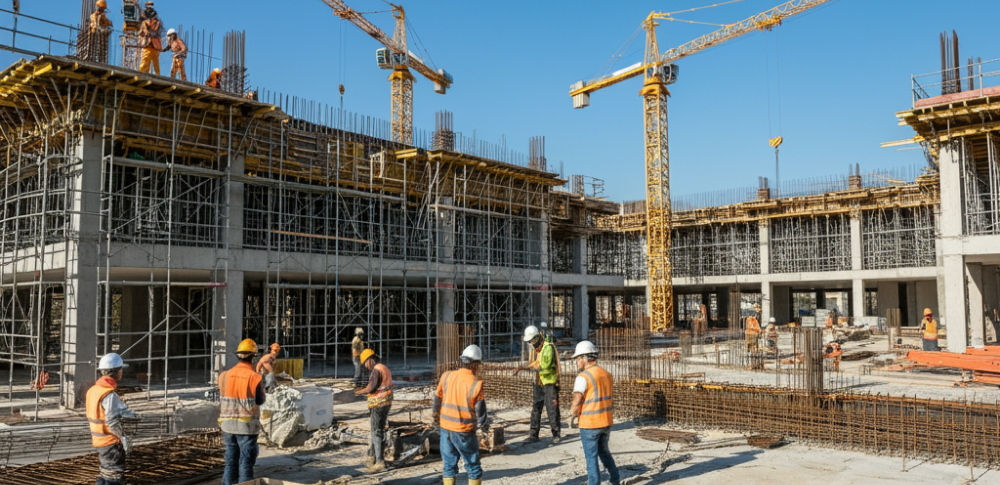The construction industry is undergoing a transformative era, marked by the development of advanced materials designed to improve durability, efficiency, and sustainability. These modern materials address the growing demand for innovative solutions to meet evolving building standards and environmental challenges. By integrating cutting-edge materials into construction, builders can create structures that are not only long-lasting but also more sustainable and cost-effective.
Advanced Concrete for Long-Lasting Structures
Concrete remains a cornerstone of construction, but innovations like self-healing concrete are redefining its potential. This advanced material incorporates microcapsules filled with bacteria that activate upon exposure to water, sealing cracks automatically. This capability reduces maintenance costs and extends the lifespan of concrete structures. Additionally, Ultra-High-Performance Concrete (UHPC), known for its exceptional strength and resilience, is becoming a go-to material for demanding projects such as bridges and high-rise buildings.
Engineered Wood: Strong and Sustainable
Traditional wood is being replaced by engineered alternatives like cross-laminated timber (CLT) and glulam. These materials are crafted by bonding layers of timber under pressure, resulting in products that are stronger, more stable, and resistant to environmental stresses. Engineered wood is a sustainable choice, as it utilizes fast-growing trees and produces less waste compared to conventional construction materials. It’s gaining traction in residential and commercial projects, offering an eco-friendly substitute for steel and concrete while maintaining structural integrity.
Smart Glass for Energy Efficiency
Smart glass technology is revolutionizing building design with its ability to adapt to changing environmental conditions. This innovative material alters its transparency based on light or heat, optimizing indoor temperatures and reducing reliance on artificial cooling or heating systems. By lowering energy consumption, smart glass not only enhances comfort but also contributes to the sustainability of modern buildings. Its application in office spaces, homes, and public structures is growing as architects prioritize energy-efficient solutions.
Recycled and Eco-Friendly Materials
Sustainability is at the forefront of modern construction, with recycled and eco-friendly materials becoming increasingly popular. Recycled steel, plastic composites, and reclaimed wood are being used to minimize the environmental impact of new builds. These materials maintain high performance while reducing the need for virgin resources, making them an excellent choice for eco-conscious builders. Additionally, using waste-derived materials like fly ash in concrete or recycled glass in flooring adds an innovative edge to sustainable construction practices.
3D Printing: The Future of Construction
3D printing is revolutionizing how buildings are constructed. With materials such as quick-curing concrete and specialized polymers, 3D printers can produce entire building components with precision and minimal waste. This technology enables rapid construction of complex designs that would be challenging with traditional methods. As 3D printing continues to advance, it holds the potential to significantly reduce project costs and timelines, making it a game-changer in the industry.
High-Performance Insulation for Comfort
Energy efficiency is critical in construction, and modern insulation materials like aerogels and vacuum-insulated panels are leading the charge. Aerogels, known for their lightweight and high thermal resistance, are ideal for buildings in extreme climates. Vacuum-insulated panels offer superior insulation with minimal thickness, making them perfect for space-constrained projects. These materials not only reduce energy bills but also enhance indoor comfort, making them an essential part of high-performance building designs.
Why Modern Materials Matter
The adoption of modern construction materials offers a myriad of benefits. They enhance structural longevity, reduce maintenance needs, and improve energy efficiency. Additionally, the environmental impact of construction is significantly reduced through the use of recycled and sustainable resources. For builders, these materials provide opportunities to meet evolving building codes and client expectations, while architects can explore creative designs that were once unattainable with traditional materials.
Modern construction materials are reshaping the industry, allowing for the creation of smarter, more durable, and sustainable buildings. By staying ahead of these innovations, construction companies can ensure they remain competitive and aligned with the future of construction.


Hi, this is a comment.
To get started with moderating, editing, and deleting comments, please visit the Comments screen in the dashboard.
Commenter avatars come from Gravatar.